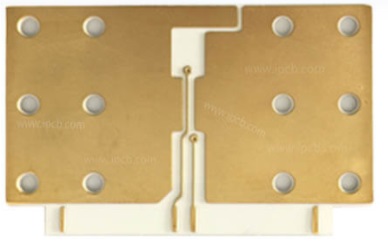What is aluminum nitride substrate:
Aluminum nitride substrate refers to a ceramic material with aluminum nitride (AIN) as the main crystalline phase, and then etched with metal circuits on the aluminum nitride substrate, which is the aluminum nitride ceramic substrate.
Aluminum nitride is a ceramic material with high thermal conductivity, which is commonly used as a semiconductor material due to its high thermal conductivity. Its high thermal conductivity makes it an ideal choice for semiconductors, and its high electrical insulation performance makes it an ideal material for sintered bodies. It is also used in many other applications and is an excellent heat dissipation material.
Aluminum nitride ceramic is a very useful material in various applications. It is a high-temperature material with excellent conductivity and thermal conductivity. It is also used for high-power electronics and LED lighting technology. It is also a good heat dissipation material. It is very durable and can be applied in various fields, and can be found in almost any metal in various applications.

aluminum nitride substrate
Application of aluminum nitride substrate:
1: Aluminum nitride as substrate material
The substrate used for packaging not only needs to meet the basic requirements of high resistivity, high thermal conductivity, and low dielectric constant, but also needs to have good thermal matching with semiconductor materials such as silicon wafers, have characteristics such as easy molding, high surface flatness, easy metallization, easy processing, low cost, and certain mechanical properties.
Aluminum nitride substrate has a series of excellent characteristics such as excellent thermal conductivity, reliable electrical insulation, low dielectric constant and dielectric loss, non-toxic, and coefficient of thermal expansion matching with silicon. The thermal conductivity can reach 170W/(m • k), which is more than 5 times that of traditional substrate material alumina. Compared with other electronic grade ceramic materials, it is very suitable for insulation substrates of high-power devices, heat dissipation substrates of ultra large scale integrated circuits, and packaging substrates from performance, cost, and environmental factors.
2: Aluminum Nitride for Deep UV LED Substrates
Aluminum nitride substrate can effectively alleviate stress accumulation during the epitaxial process, reduce epitaxial wafer defects, and significantly improve the performance and lifespan of deep ultraviolet LED devices. In addition to the general properties of wide band gap semiconductor materials such as large band gap (6.2 eV band gap), high breakdown electric field strength, high thermal conductivity and high chemical stability, aluminum nitride also has excellent ultraviolet light transmittance, and is an ideal material for preparing ultraviolet photoelectric product devices (such as purified water, disinfection, communication, sensors, medical treatment and photolithography).
3: Aluminum nitride is widely used in thermal interface materials (TIM)
Thermal conductive silicone grease filled with high thermal conductivity particles such as aluminum nitride (AlN), also known as thermal conductive paste, has a certain fluidity and is a common traditional heat dissipation material with good thermal performance and shorter manufacturing cycle; Low viscosity, easy to fill interface voids.
4: Aluminum Nitride as an Ultra High Temperature Packaging Material
The melting point of aluminum nitride (AlN) is as high as 2500 ℃, which can be used as high-temperature and heat-resistant materials. The coefficient of thermal expansion of aluminum nitride is similar to the coefficient of thermal expansion of Si and SiC. After thick film metallization, it can meet the requirements of temperature up to 500 ℃ and power density of 1000W/cm2. Aluminum nitride ceramic chip level packaging can be applied to ultrahigh temperature (above 500 ℃) microelectronic devices.
5: Aluminum Nitride as a High Power Device Material
In wireless transceiver systems, the solid-state amplification circuit of the transceiver module (TR module) uses a wide bandgap semiconductor power device with higher output power. Aluminum nitride (AlN) with high thermal conductivity can transfer internal heat to the heat sink, avoiding excessive internal temperature inside the module. TR components fully utilize the high thermal conductivity and strength characteristics of aluminum nitride substrates, adopting multi-layer high-temperature co firing technology to solve the vertical interconnection of RF signals in high-density assembly of stacked structures, as well as issues such as heat dissipation and sealing.
6: Aluminum Nitride as a High Frequency Device Material
Aluminum nitride can be used as a collector, clamp, and energy transfer window for microwave tubes. The dielectric loss of aluminum nitride can be as low as 10 ^ (-4). When the window heat is too high, it can effectively ensure the safety of electronic devices.
7: Aluminum nitride used as a thin film material
Aluminum nitride thin film material has good thermal stability and piezoelectric properties at high temperatures, and can work in high temperature environments close to 1200 ℃, making it a high-performance piezoelectric material. Aluminum nitride thin films can be applied in micro modules, sensors, integrated circuits, and active components.
Aluminum nitride (AlN) substrate have a series of excellent characteristics such as high thermal conductivity, high resistance, low dielectric loss, thermal expansion performance that matches semiconductor materials such as silicon, and good mechanical properties. Aluminum nitride electronic ceramics have become an important direction to solve the heat dissipation problem of highly integrated and miniaturized electronic devices, effectively ensuring the reliability and safety of electronic devices.